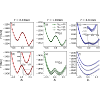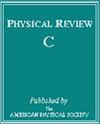Global properties of nuclei at finite-temperature within the covariant energy density functional theory
IF 3.1
2区 物理与天体物理
Q1 Physics and Astronomy
引用次数: 0
Abstract
In stellar environments nuclei appear at finite temperatures, becoming extremely hot in core-collapse supernovae and neutron-star mergers. However, due to theoretical and computational complexity, most model calculations of nuclear properties are performed at zero temperature, while those existing at finite temperatures are limited only to selected regions of the nuclide chart. In this study we perform the global calculation of nuclear properties for even-even nuclei at temperatures in range MeV. Calculations are based on the finite-temperature relativistic Hartree-Bogoliubov model supplemented by the Bonche-Levit-Vautherin vapor subtraction procedure. We find that near the neutron-drip line the continuum states have significant contribution already at moderate temperature MeV, thus emphasizing the necessity of the vapor subtraction procedure. Results include neutron emission lifetimes, quadrupole deformations, neutron-skin thickness, proton and neutron pairing gaps, entropy and excitation energy. Up to the temperature MeV, the nuclear landscape is influenced only moderately by the finite-temperature effects, mainly by reducing the pairing correlations. As the temperature increases further, the effects on nuclear structures become pronounced, reducing both the deformations and the shell effects.

协变能量密度泛函理论中有限温度下原子核的全局特性
在恒星环境中,核在有限温度下出现,在核心坍缩超新星和中子星合并中变得极热。然而,由于理论和计算的复杂性,大多数核性质的模型计算都是在零温度下进行的,而有限温度下的核性质计算只局限于核素图的选定区域。在本研究中,我们对温度范围在 0≤T≤2 MeV 的偶偶数 8≤Z≤104 核进行了核性质的全局计算。计算基于有限温度相对论哈特里-博戈柳波夫模型,并辅以邦奇-列维特-沃特林蒸汽减法程序。我们发现,在中子滴落线附近,连续态在中等温度 T≈1 MeV 时就已经有了很大的贡献,从而强调了蒸汽减除程序的必要性。结果包括中子发射寿命、四极子变形、中子皮厚度、质子和中子配对间隙、熵和激发能。在温度 T≈1 MeV 之前,核景观只受到有限温度效应的适度影响,主要是通过降低配对相关性。随着温度的进一步升高,核结构受到的影响变得明显,变形和壳效应都会减弱。
本文章由计算机程序翻译,如有差异,请以英文原文为准。
求助全文
约1分钟内获得全文
求助全文
来源期刊

Physical Review C
物理-物理:核物理
CiteScore
5.70
自引率
35.50%
发文量
0
审稿时长
1-2 weeks
期刊介绍:
Physical Review C (PRC) is a leading journal in theoretical and experimental nuclear physics, publishing more than two-thirds of the research literature in the field.
PRC covers experimental and theoretical results in all aspects of nuclear physics, including:
Nucleon-nucleon interaction, few-body systems
Nuclear structure
Nuclear reactions
Relativistic nuclear collisions
Hadronic physics and QCD
Electroweak interaction, symmetries
Nuclear astrophysics
 求助内容:
求助内容: 应助结果提醒方式:
应助结果提醒方式:


